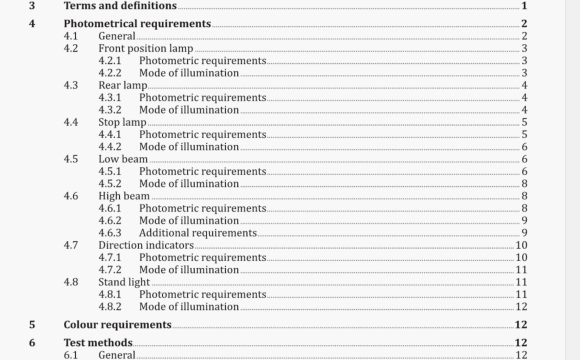ISO 6742-1 pdf download – Cycles — Lighting and retro-reflective devices — Part 1: Lighting and light signalling devices.
4.4 Stop lamp
4.4.1 PhotometrIc requirements
The minimum intensity measured on the reference axis at point H = V = 0 of a stop lamp shall be the highest of the following two values, as appropriate:
— 40cdmin;
— where a stop lamp function is provided by a rear lamp, at least five times the greatest measurable intensity of the rear lamp.
The greatest measurable intensity of the stop lamp shall not exceed 185 cd.
Light shall be emitted from a stop lamp throughout a zone defined as follows with respect to direction point H V 00: ± 45 horizontally and ± 15 0 vertically. Throughout the field of emission the intensity shall not be less than 0,3 cd.
The intensity in specified directions within the grid according to Figure 3 shall be not less than specified percentages of the minimum point H = V = 0 • Intensity. The angles and percentages relative to the point H = V = 0 direction and value (100%) are specified in Figure 3.
6 Test methods
6.1 General
During photometric measurements, stray reflections shall be prevented by appropriate masking.
In all cases, the distance of measurements shall be such that the law of the inverse of the square of the distance Is applicable.
For all values expressed in lux, the measurements are performed on a vertical screen P fitted 10 m in front of the lamp. If the distance of measurement is different than 10 m. the result of measurements shall be expressed at 10 m following the law of the inverse of the square of the distance. The measuring equipment shall be such that the angular aperture of the receiver viewed from the reference centre of the lamp is between 10’ and 1°.
The intensity requirement for a particular direction of observation shall be deemed to be satisfied if that requirement is met in a direction deviating by not more than 15’ from the direction of observation.
For any lamps, except those equipped with filament lamps, the luminous intensities and colour measured after 1 mm and after 30 mm of operation shall comply with the requirements. The luminous intensity distribution after one minute of operation can be calculated from the luminous Intensity distribution after 30 mm of operation by applying at each test point the ratio of luminous intensities measured at H V 0 after I mm and after 30 mm of operation.
In case of short pulses. the effective intensity of flashing light shall be measured according to Annex A.
If a lamp has flashing and continuous modes provided by the same light source(s), its performance shall be measured mainly in continuous mode. The intensity in flashing mode shall be measured only in reference axis, with flashing intensities in other directions calculated in proportion to the continuous intensity In those directions compared to reference axis.
The LF.D colour shall be measured according to test method described in CIE 1931.
6.2Power supply and light source to test photometrical performances
Thelamp shall be equipped with thelightsourcesspecified bythe manufacturerandoperatedatits referenceluminous flux, for the voltage specified by the manufacturer according to IS0 6742-4 and lS0 6742-5.
For lighting devices working with power supplied by cycle’s movement defined in ISO 6742-4, Clause 4,it’s possible to use DC or AC power supply as described below:
a)Lighting devices with LED
Test voltage 6 V ; the current shall not exceed:
1)for 2,4 w headlamps [for 3 w / 2,4 w – systems): 440 mA;2for 1,2 w headlamps [for 1,5 w – system): 220 mA;
3) for 0,6 w rear lamps (for 3 w – system): 110 mA;4]for 0,3 w rear lamps (for 1,5 w – system): 55 mA.Alternatively the devices can be measured with test current:
1)for 2,4 w headlamps (for 3 w / 2,4 w systems): 400 mA;2) for 1,2 w headlamps (for 1,5 w – system): 200 mA;3for 0,6 W rear lamps (for 3 w – system): 100 mA;4)for 0,3 w rear lamps (for 1,5 w – system): 50 mA.The voltage shall not exceed 6,7 V.
b)Lighting devices with filament bulbs
1)changeable filament lamp: luminous flux according to lamp data sheet;2non-changeable lamp: 6 V.
6.3Installation on test bench
The lamp shall be installed on thetest bench according to the recommendations of the cycle manufactureror, those of the constructor of the lamp.
During the measurements the light shall be fit in accordance with the manufacturer.lf this is not clearly defined in the instruction manual there are two possibilities:一H-H is the line where the illumination on this line and above is not higher than 2 lx;一 H-H is the line 3,5 ° above Emax-
NOTE Values in lux measured on a vertical wall at 10 m ahead from headlamp.
ISO 6742-1 pdf download – Cycles — Lighting and retro-reflective devices — Part 1: Lighting and light signalling devices
